|
 Chapter 20 Lecture Notes Chapter 20 Lecture Notes
Formulas:
B = moI/2pr "Into" Ä
B= NmoI/(2R) "Out" ¤
B = monI
SBúúDl = moI
F = Bqvsinq
r = mv/Bq
m = (er2/2V)B2
F = ILBsinq
t = NIABsinj
F/L = I2I1mo/2pd
Constants:
 Demonstrations: Demonstrations:
- Bar Magnets attractive and repulsive
- Field from bar magnet and horseshoe magnet.
- Field from a wire
- Bending electron beam
- Force from two wires
Magnets and Magnetic Fields
This is sometimes a complicated subject, because although we use it every day in every motor, we don't really come in contact with magnetism. Also, the way the force of
magnetism acts is unlike any we have come in contact with yet in our study of physical phenomena. It is a property that always requires three dimensions to describe. Because
magnetism involves three dimensions, we often have to draw vectors into the plane of the paper or out of the plane of the paper. We represent vectors like that as arrows. But all we
see is either the tip of the arrow ¤, if the field is coming out of the page, or the tail of the arrow, Ä, if the field is going into the page.
Permanent Magnets and Magnetic Fields
Magnetic material has been known for a long time and used in navigational compasses by the Chinese at least by the 11th century. Magnetic material was first found in Magnesia in Asia
Minor and was named after the place where it was found. Most magnets have iron in them and are called ferromagnetic (from the Latin ferrum for iron). Each magnet has two poles, North and South. The names were given because a permanent magnet will always have its north pole point to magnetic north (which is actually somewhere in the
middle of Hudson bay). Magnetic poles always come in pairs. No monopoles, (like single
electric charges). If you cut a magnet, you still get a north and south. There is no "Coulomb's Law" for magnetic fields. Opposite poles attract and like poles repel. So the north pole of a compass points to magnetic
north of the earth (which is really a south magnetic pole). The north pole of a compass should be called the "north seeking" pole. Surrounding a magnet is a magnetic field. We can draw field lines always going from north to south. At each point in space, the field points in the direction that the north pole of a little
compass would point. The direction of the magnetic field is tangent to the field lines. Fields have the capability of producing forces on certain particles. Magnetic field lines have no beginning and no end. They are always continuous loops. This is
because there are no monopoles, (single north or south poles). Remember that electric field lines always started and ended on charged objects. This happens because there are electrically
charged objects with a single charge. Because there are no magnetic objects with a singlepole, there is no place for the magnetic field to start or end, so magnetic field lines are always continuous. The strength of the field is proportional to the number of lines per unit area (the density of lines).
Geomagnetism
The earth has a magnetic field. Magnetic north pole is like the south pole of a magnet since "north seeking poles" point north.
Lines go at an angle here in DelMarVa. Also, our compasses point about 3°W of true
geographic north. (Not because of lines at an angle, but because of "Hudson Bay.") The earth's magnetic field is set up, not because of permanent magnets, but by rotation of the iron core.
Electric Currents Produce Magnetism
I am not going to follow the order that the book presents the material. Instead, I am
going to continue the discussion of the source of magnetic fields. We have talked briefly about permanent magnets, and now we will talk about another way to make a magnetic
field: by moving charges. Actually, all magnetic fields we know about (if there are no monopoles) are made from moving charges. Even permanent magnets are made because subatomic charged particles are moving in atoms.
Magnetic Field of a Wire (Hans Christian Oersted – 1820)
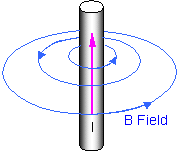 The field goes in circles around the wire. The direction is given by the right hand rule. Thumb is in direction of current.
The fingers curl in the direction of the magnetic field. What is its magnitude? A drawing of the field lines shows they go in circles around the wire and are denser near the wire. Where
the field lines are denser, the magnetic field is stronger. It is stronger near the wire. The field goes in circles around the wire. The direction is given by the right hand rule. Thumb is in direction of current.
The fingers curl in the direction of the magnetic field. What is its magnitude? A drawing of the field lines shows they go in circles around the wire and are denser near the wire. Where
the field lines are denser, the magnetic field is stronger. It is stronger near the wire.
The magnitude is given by the formula
B=moI / 2pr
I is the current in the wire. mo is the permeability of free space. r is the distance from the wire. B is the
magnetic field. The SI unit for magnetic field is called the "Telsa". We will talk about this more later.
Notice that the field is strongest near the wire. Double the distance cut the field in half. Double the current, double the field.
mo = 4p´10-7 T× m/A.
 |
 |
|
PROBLEM: One
straight wire carries a current of 10 Amps north and another straight wire carries a current of 5.0 Amps west. What is the direction and magnitude of the magnetic field 0.25 m above
the point where the wires intersect?
Above first wire is:
B1 = (moI)/(2pr) = (4p´10-7 T×m/A)(10 A)/(2)(p)(.25 m)
B1 = 8.00´10-6 T in the eastern direction
Above the 2nd wire is:
B2 = (moI)/(2pr) = (4p´10-7 T×m/A)(5.0 A)/(2)(p)(.25 m)
B2= 4.00´10-6 T in the northern direction.
I must add these up as vectors. They are already broken up into components at
right angles. One is north and one is east. Thus, the total field is
B =
 = 8.9´10-6 T = 8.9´10-6 T
at an angle of q = tan-1(B2/B1) = 27° north of east.
|
|
|
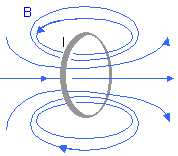 Magnetic Field of a Wire Loop Magnetic Field of a Wire Loop
What about a loop of wire? Each section of the wire gives a magnetic field with the direction determined by the right hand
rule. The magnetic field inside the wire is in a different direction from the magnetic field outside the wire. At the center of the loop
B=NmoI / 2pr
N = number of turns. I = current in the wire. R is the radius of the wire. This acts like a short bar
magnet. This equation is not in the book.
Ampere's Law
There is a fundamental principle which allows us to calculate the magnetic field from any wire carrying a current. André Marie Ampere determined that if we take any closed path
around a current carrying wire and looked only at the vector component of the magnetic field parallel to that closed path, you would find
SBúúDl = moI
where Dl is a little segment of length, Búú is the magnetic field parallel to that little segment of length,
"S" means to take the sum over Búú times Dl, and I is the current flowing through the wire. (Actually
this is a calculus relationship with an integral.) If we look at a single wire (see Figure 20-2), we see that B is always parallel to a circle around the wire, so Dl is just the circumference of the circle, and
B(2pr) = moI
B= (moI)/(2pr) which is what we got before.
Magnetic Field of a Solenoid
 If I now take many turns of wire, and pack them
tightly, I get a solenoid. Inside the solenoid, the magnetic field is approximately constant and outside the solenoid the magnetic field is approximately zero.
See Figure 20-23. The direction of the field is given by the RHR and the magnitude can be determined using Ampere's law. If I now take many turns of wire, and pack them
tightly, I get a solenoid. Inside the solenoid, the magnetic field is approximately constant and outside the solenoid the magnetic field is approximately zero.
See Figure 20-23. The direction of the field is given by the RHR and the magnitude can be determined using Ampere's law.
SBúúDl = moI
Bl = NmoI
B = moIN/l = mon
I
where n = number of turns per unit length and I is the current in the loop.
 |
 |
|
PROBLEM: A solenoid has 100 turns and a length of 10 cm. It carries a current of
0.500 A. What is the magnetic field inside the solenoid?
B = monI = moIN/L = (4p´10-7T×m/A)(100)(0.500A)/(0.100m)
B = 6.28´10-4 T
|
|
|
Magnetic Fields Exert a Force on a Moving Charge
We have talked about how magnetic fields are created from moving charges. Now once
we have created the magnetic field, we want to know what effect it has on other particles. We will now discuss what effect a magnetic field has on a charged particle.
Characteristics of the Force
A magnetic field can create a force on an object. However, for the object to feel a force,
and the magnetic field to affect the object, three things must be true
The object must have an electric charge. The charged object must be moving. The velocity of the moving charged object must have a component that is perpendicular to the
direction of the magnetic field.
A slightly different "Right Hand Rule" (RHR) is used to determine the direction of the
force on a charged particle from a magnetic field. Index finger points in direction of the particle's velocity, the middle finger points in the direction of the magnetic field, and the
thumb points in the direction of the force on a positive charge - the direction a positively charged particle will accelerate.
Definition of Magnetic Field
Remember that there was a relationship between the electric field and the force that a
charged particle felt. That relationship was qE=F. Similarly, there is a relationship between a magnetic field and the force a charged particle feels. It is
F = qvBsinq
Remember that force is a vector, and there is a direction to this force. The direction is
given by the RHR as explained above. If we look at this equation we can see four different ways to increase the force a particle feels from a magnetic field? Increase B. Increase q. Increase v. Maximize sinq. The sign of q must be used.
Because, SF = ma, the particle will always have an acceleration that is perpendicular to its motion and
perpendicular to the magnetic field.
Another way to express this is
B = F/q(vsinq)
SI units are newton-second/(coulomb-meter) = 1 Tesla (T)
We also use a non SI unit. 1 Gauss = 10-4 tesla.
 |
 |
|
PROBLEM: A proton moves at 8.0 ´ 106 m/s along the x axis. It enters a region where there is a magnetic field of magnitude 2.5 T directed at an angle of 30° from the positive y-axis and lying in the xy-plane. What is the initial force
the proton feels and what is its acceleration?
F = qvBsinq = (1.6´10-19C)(8.0´106m/s)(2.5T)(sin(60°)) = 2.8´10-12N directed out of the page (the positive z direction).
F = ma Þ a = F/m = 2.8´10-12 N/1.67´10-27 kg = 1.7´1015 m/s2
directed in the positive z direction.
|
|
|
Result of the Force (Motion of Charged Particle)
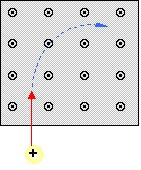 The motion of a charged particle in a magnetic field would be a circle. (Show how that works). To keep this motion there must be a
force causing the centripetal acceleration. That is the magnetic force. The motion of a charged particle in a magnetic field would be a circle. (Show how that works). To keep this motion there must be a
force causing the centripetal acceleration. That is the magnetic force.
F = mv2/r = qvBsinq
In this case q is 90 degrees, so sinq is 1.
F = mv2/r = Bqv Þmv/r = Bq, or r = mv/Bq
The radius of the motion is given by the particle's mass, magnetic field, charge, and
velocity. Suppose I have the paths of two or more particles in a magnetic field. This equation allows me to determine the relationship between the particles' mass, velocity
and/or charge. This is one of the most important concepts in physics. For instance, suppose I know B, q, and r? I then get mv =momentum, and particles of different masses
and/or charges will have different radii.
Work
Since W = Fdcosq, and q and the force and direction of d are always 90 degrees different apart
for the case of a charged particle in a magnetic field, a magnetic field can dono work on a charged particle. (Note that this means the acceleration is always 90 degrees away from the direction of motion
for a charged particle experiencing the effects of only a magnetic field.)
Mass Spectrometer
The mass spectrometer illustrates many points. It is used to measure the mass of a particle.
 |
 |
|
PROBLEM: A particle is accelerated across a potential difference. (a) What is the speed of the particle?
K = DU = qDVÞ (1/2)mv2 = qV
(a) For a singly ionized ion, q =e, so

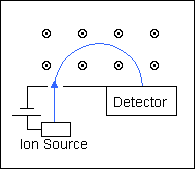 (b) What work is done by the field? (b) What work is done by the field?
B field? None
(c) What is the mass?

 so, so,

(d) What force does the particle feel when it enters the field?
F = Bevsin(q ) àq = 90°
(e) What if B is in direction of motion? Then it feels no force.
|
|
|
Sometime another magnetic field is placed in the same region as the electric field and
perpendicular to the electric field. When the particles go straight through that is because the electric force is balanced by the magnetic force, so that qE = qvB¢Þ v=E/B¢
A television works using the same principle as a mass spectrometer. A potential
difference accelerates the electrons, and a magnetic field bends them to hit different luminous regions on the screen. There are two parts to a problem like this. (1) Accelerate
the electrons across a potential difference (like a capacitor). (2) bend them in a magnetic field.
Magnetic Fields Exert a Force on a Current in a Wire
What is a current in a wire? Moving charges. What does a magnetic field do to moving
charges? Exerts a force. What does a magnetic field do to a wire. Exerts a force.
F = qvBsinq. Multiply right side by 1 (t/t)
F = (q/t) vt Bsinq q/t is current, and vt is length.
F = ILBsinq whereq is the angle between the wire and the direction of the B field.
A stereo speaker works by using this principle. If current increases the force increases. The direction is given by RHR.
 |
 |
|
PROBLEM: A wire with a mass of 1.00 g/cm is placed on a horizontal surface with a
coefficient of friction of 0.200 N/m. The wire carries a current of 1.50 A eastward and moves horizontally to the north at a constant speed. What are the magnitude and
direction of the smallest magnetic field that enables the wire to move in this fashion?
By Newton's second law SF
= ma
In the y-direction we have the Normal force Fn and the force of gravity, mg.
SFy = may
Fn – mg = 0
In the x-direction we have the magnetic force (FB = ILBsinq) and the force of Friction (mFn) which is proportional to the normal force.
Thus,
SFx = max
ILBsinq – mFn = 0
Putting these two equations together, and doing a little algebra with the realization that q = 90o, we get
IB = mmg/L
B=mg(m/L)/I
B = (.200 N/m)(9.8 m/s2)(1.00g/cm)(100cm/meter)(1kg/1000g)/1.5A
B = .131 kg m/ m-A-s2 = .131 N/A-m = .131 Tesla
|
|
|
Magnetic Fields Exert a Torque on a Current in a Coil
Now put a current carrying loop of wire in an already present magnetic field. There is a
force on the loop due to the current in the wires and the force on all the wires creates a net torque. The torque is given by force multiplied by the length of the lever arm:
t = Fl = ILB(sinq)(w/2) sinj ( ´2 ) = IABsinj
A is the area of the loop. It is valid for any flat coil. For more than one loop
t = NIAB sinj where NIA is called the magnetic moment of the coil and given the symbol m,
so in general:
t = mB sinj
This is a direct current motor. If I run current through the wire, the torque causes it to
rotate and I can do work with the rotating coil.
WOW! A motor is possible because current in a wire feels a magnetic force! If there were no relationship between magnetism and electricity would mean no such motors!
 |
 |
|
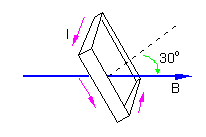 PROBLEM
: A square loop of wire with sides of 50.0 cm is oriented at an angle of 30° to a magnetic field of
0.50 T. The current in the loop is 2.0 A in the direction shown. What is the magnitude of the torque at this instance? PROBLEM
: A square loop of wire with sides of 50.0 cm is oriented at an angle of 30° to a magnetic field of
0.50 T. The current in the loop is 2.0 A in the direction shown. What is the magnitude of the torque at this instance?
t = NIAB sinj
t = (2.0 A)(0.50 T)(0.50)2(sin(30°))
t = 0.13 m×N
It will rotate clockwise (the force are toward the top of the page for the top arm
and toward the bottom of the page for the bottom arm).
|
|
|
Force Between Two Wires
Okay, what do we know about currents in wires.
- They produce a magnetic field.
- They feel a force from magnetic fields.
Consequently, two wires with currents running in them will produce magnetic fields that influence each other.
From wire number 1:
B = moI1/2pr
At wire 2:
F = I2LBsinq where B comes from wire 1.
So F = I2I1Lmo/2pr.
The direction of force depends on whether the currents are in the same direction or
opposite directions, and can be determined from the right hand rule. If the currents are in the same direction, then the two wires will be attracted to each other. If they are in opposite
directions, then they will be repelled from each other. We can write this as the force per unit length.
F/L = I2I1mo/2pd
Two wire Forces with directions indicated.
 |
 |
|
PROBLEM: Two long parallel conductors are carrying currents in the same direction. Conductor A carries a current of 150A and is held firmly in position. Conductor B carries IB and is allowed to slide freely up and down parallel to A between a set of non-conducting guides. If the linear mass density of B is 0.10 g/cm, what value of the current IB will result in equilibrium when the distance between the conductors is 2.5 cm?
From Newton's second law:
F/L = gm/L = IAIBmo/2pd
IB = 2pdg(m/L)/moIA
IB = 2p(2.5cm)(9.8 m/s2)(0.1g/cm)(1kg/1000g)/(4p´ 10-7 T×m/A)(150A)
IB = 82 N/T-m (N A-m /N-m) = 82 A
|
|
|
Magnetic Materials
 Ferromagnetism Ferromagnetism
Induced Magnetism
|